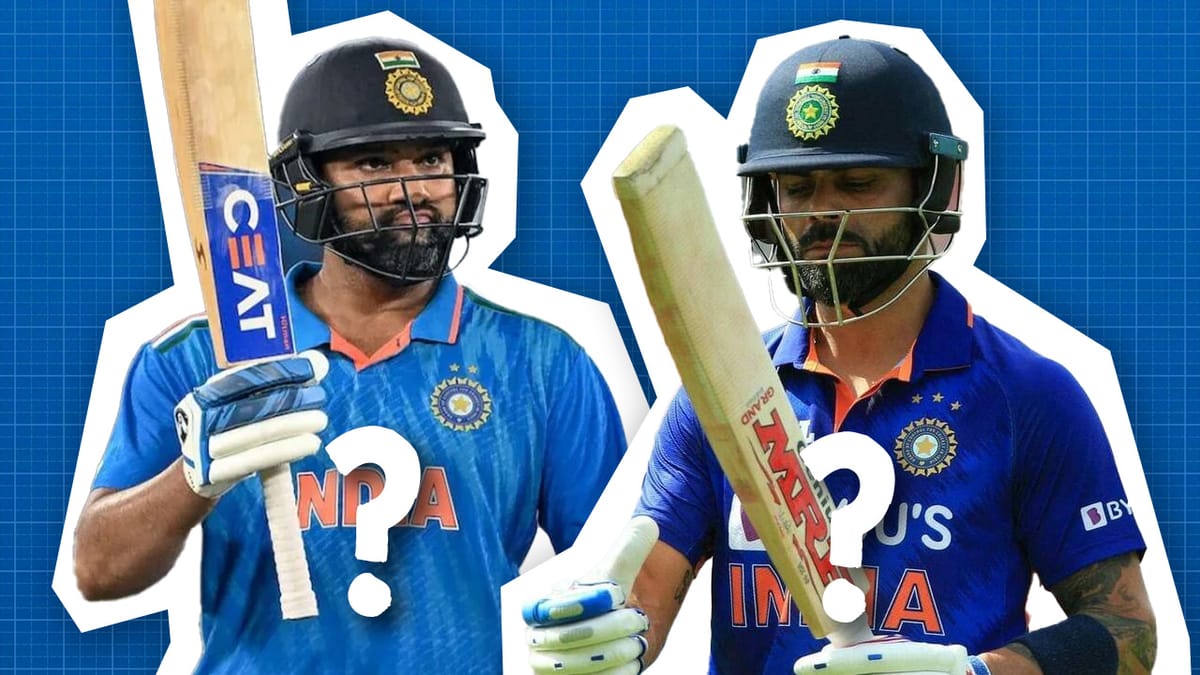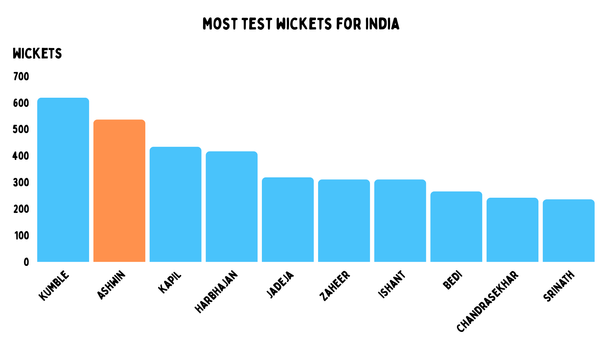Do India have a problem against spin?
Are India suddenly bad against spin?

Download Hitwicket FREE for iOS/Android and build your dream team!
Stats from Statsguru (as of August 14) and Himanish Ganjoo's database. True values by Varun Alvakonda
The 1981/82 Ranji Trophy semi-final is one of the most important matches in the history of batting. Bombay (now Mumbai) were in a lot of trouble, as Karnataka took a first innings innings lead. In the Ranji semi-finals, that is enough to proceed to the big match.
But Karnataka didn’t just want to win on first innings. They had a chance of beating Bombay – the best team in Ranji history – by an innings, and the wicket was spinning sideways. So they went for the kill with their left-arm orthodox bowler, Raghuram Bhat. He had taken eight wickets in the first innings.
Bombay's captain was Sunil Gavaskar, and he tried to promote their only left-hander up the order. He did that, and the batter made nine. The great Indian opener kept sliding himself down the order. There may have been a reason for this, because there was a discussion about what would happen next. Sharad Diwadkar, the team manager, was freaking out because of Gavaskar’s plan. But the little master had his way.
Gavaskar went out to bat down the order, left-handed. But it was not a switch hit or reverse sweep. He stood there as if he was a left-hander after a career spent on the other side of the bat. This was only when facing the left-arm spinner, he faced the offspinner in his traditional way. He batted for ages, as a left-hander at one end and conventionally at the other. Bhat tried every single trick, but he couldn’t get Gavaskar, who saved his team from an innings defeat.
India play spin on a level that is insane. Sehwag didn’t consider offspinners as bowlers and went after spinners without any thought. Dravid was algorithmic in the way he played cricket, inspiring other batters since. VVS Laxman could use his feet to get down to a ball pitched in the footmarks and still drive it through the covers.
Even in the modern era, we’ve seen some great batters of spin from India – Virat Kohli, Rohit Sharma, and Cheteshwar Pujara. Of recent times, Shreyas Iyer, Rishabh Pant, and Shubman Gill have shown their talent against the turning ball. And we now see players like Shivam Dube, Rajat Patidar, and Abhishek Sharma who are incredible at smashing spin in T20 cricket.
Yet, in the last few years, the narrative has been that the Indian batters are not good against it anymore. And it’s not really format-specific either. In the last few years, they struggled to score big runs in home Tests from 2021 to 2023, knocked it around in the 2022 T20 WC semi-final, and lost an ODI series in Sri Lanka and Bangladesh.
Do India have a problem against spin?
Let’s start with ODIs, the format they played most recently. India started averaging over 40 in the 1990s, and their highest overall mark against spin bowlers came in the previous decade – which is also when the two new balls rule was introduced. But how did they fare compared to their opposition?
In the 1970s, the Indian team averaged 21.55 less than their opponents against spin in those matches. But there weren't a lot of ODIs played in those days. They were slightly ahead in the 1980s, and they were considerably better every decade since. The batters and spinners were at their best in the 2010s. And that is very important to remember.

When we look at it in terms of the ratio of their average and the opponent’s average versus spin, it was 1.63 in the 2010s. Their ratio in the current decade (though it has only been four and a half years) does see a drop off, but it is still the second-best ever in their history. But because it's being compared to their best, people are noticing it. Now, some of this is because they’ve had some very good white-ball spinners in the modern era. But this is clearly not their worst era of playing spin in ODIs.

If anything, they have also started to attack spin more. In the 2010s, they looked to knock the ball around and only attack after the 30th over. Now, they are following the same style that England pioneered. They are not trying to be set and then play safe. It’s a very different model.

So if we do a breakdown of the averages by year since 2000, it was more than 70 in four different years. But for the first time since 2007, the opposition averaged more than India against spin in 2020 and 2021. Even if this is partly down to attacking, it is certainly something we haven’t seen before.

The speed of run-scoring also matters. India scored at more than a run a ball in 2021, but that was from only two series against England and Sri Lanka. They were above five runs per over every year in a ten year period. They were also noticeably scoring quicker than their opponents from 2014 to 2018. But from 2019 onwards, you do see that things start to change a little bit again. And part of this is probably from them trying to attack and being dismissed.

But there are so many factors here. India’s dominance with the bat started when Kohli and Rohit entered their peak batting years. In 2017, India also moved on from finger-spin and gave a go to Kuldeep Yadav and Yuzvendra Chahal. At their best, the wrist-spin duo posed a wicket-taking threat across conditions.
If we compare Kohli and Rohit’s record against spin by decade in ODI cricket, there are some interesting patterns here. Rohit averaged 84 and struck at 97, while Kohli was at 76 and 94. They scored a lot of runs at a very good strike rate.

However, in the 2020s, Rohit’s role changes to that of an aggressor, particularly in the powerplay. His average is less than half of what it was, but at a strike rate of 112. He scores a lot quicker because he has attacking options available to him. And that approach probably helps him on turning tracks, because he's scoring runs so quickly that the ball with his name on it doesn't get him out.
This makes Kohli look bad. But look closer, and you'll see he is still averaging more than 50 against the turning ball. A strike rate of 85 is a little slow, but it's not too bad. However, he used to be a lot more effective against it.
Kohli and Rohit were well above the others in terms of true average and true strike rate in the previous decade. Dhawan had a similar true strike rate, but a below par true average.

Rohit is the outlier in this decade – he has a true average of 7 and a true strike rate of 32. There are quite a few players who have done well over a relatively small sample size. However, Kohli has a true strike rate of -7 but at a true average of more than 10. Most importantly, not only have these players aged, they have changed roles.

Rohit Sharma (and even Rahul Dravid) have talked about them not sweeping enough. Since 2010, their main scoring shot has been the on-drive. They flick, glance, drive and cut way more than they sweep. In this time period, India have the lowest percentage of sweep shots by a team in the format. That allows teams to set fields for them more easily than for players who are worse against spin, but have more scoring options.

In the India-Sri Lanka ODI series, the hosts attempted that shot a lot more and had better returns than them – a better average, strike rate, and balls per dismissal. Rohit mentioned that Sri Lanka scored a lot more runs square of the wicket rather than down the ground.

Is it simply a case of conditions dictating how India perform against spin nowadays? In the ODI World Cup last year, they scored more than 100 runs per wicket at 5.75 runs per over. Only New Zealand were quicker, and nobody was close in terms of average.

Over a larger sample size, India ranked second in average and third in scoring rate since the start of 2020. They are in a cluster with New Zealand and South Africa – two teams who have improved a lot against spin. However, they also play a lot of it in places where it does not spin.

As far as the overall record in this time period is concerned, Sri Lanka, Bangladesh, UAE and West Indies are among the best for the spin bowlers in ODI cricket – spinners concede less than five runs per over in each of these countries.

In terms of conditions, if we have a look at India’s average by venue country, we see that they average the lowest in Sri Lanka and Bangladesh – the two countries where they also lost an ODI series in the last couple of years.

The sample size is small in most countries, but they have played 12 matches in Sri Lanka – the most in any country away from home. Are faster spinners on ragging wickets causing issues for a team trying to up the rate more?

And conditions matter even more in Test cricket. In the last few years, India started making more spin-friendly pitches in home Tests, which reflects in the averages. India is the place to be if you are a spinner. Their slow bowlers averaged almost eight runs per wicket less than Bangladesh.

India averaged 33 at home and in Bangladesh, the two places that accentuate the turning ball the most. The rest of these countries either have other weapons or are missing a spinner.

While Indians are scoring less against spin in Tests at home, you can see they are still outscoring their opposition. Only the amount of runs has changed. The pitches are different, but the result is the same. This allows the bowlers to rest more, and completely changes Indian batting averages – who traditionally feasted on flat home wickets.

Since the start of the 1970s, India has consistently outperformed their opponents against spin bowling in every decade. However, when looking at just their batting averages in that time period, the 2020s is when they average the least. But this period was also when the Indian spinners were most effective. No one can score runs on Indian wickets anymore in Test cricket.

We also see that the ratio of the team and the opposition averages is the highest in the 2020s, despite the fact that they average the least that they ever have with the bat since the start of the 1970s. This tells us that considering the conditions, they're actually playing spin and bowling spin pretty well.

Looking at Hawkeye data, India have faced over 4000 and 3000 deliveries of ‘high’ and ‘low’ spin respectively. Whenever the degree of spin is above 3, we consider that as high spin. Obviously, lower is much easier for most. There are exceptions like Virat Kohli and Axar Patel, who have a higher average when the ball turns more.

And India have seen a huge median degree of turn in their last three series at home. It was above three degrees even in the England series, where the pitches didn't actually spin as much.

India had their highest batting average versus England when the median degree of turn was just under three. Their average fell to 26 when facing Australia, when the median spin went up to 3.65. In the Sri Lanka series, where it spun at 4.35 degrees, India still averaged 36.

This is the most fascinating graph. India are great against 90 to 99 kph bowling when it spins less, and they struggle when it turns more. Most teams would struggle against that, but I wonder if India's lack of sweeps play a part here.

On the other hand, when the speed is 80 to 89 kph, they still average less when it turns more, but the average difference reduces a lot. Indian batters are set up to face this kind of spin because they use their feet, which is much harder against 90+ kph. The numbers are a little more random for under 80 kph, but that is very rare now.
Let’s specifically look at high spin now. We see that the team that India really struggled against here was Australia, and part of the reason is because they averaged 14.73 whenever Australia bowled over 90 kmph. This was the biggest difference between what Australia managed to do in India and what England and Sri Lanka did. Sri Lanka had no deliveries in the high spin zone, whereas England couldn’t maintain it as consistently. Australia in a four match series bowled 516 deliveries in four Tests, whereas England only managed 160 across five.

Bowling faster spin effectively nullifies the use of feet, and Indian batters generally shy away from sweeping. In fact, sweeping accounts for just 3.02% of their shots. India become more of a target when you're bowling quicker at them. Instead, they prefer flicks, drives and pushes. Even cutting the ball is more common than the sweep.

T20 is also a part of the discourse of how India play spin bowling. Since the start of 2020, India holds the highest average against spin among the top 10 ranked T20I teams and is narrowly second to England in terms of runs per over. In the three T20 World Cups during this period, India clinched victory in the West Indies, reached the semi-final in Australia, and did not advance past the group stage in the UAE. Despite a boost in net run rate from the next three matches in the UAE edition, early losses in the first two games meant that India could not make it to the semi-finals. Hence, that tournament is not considered in this assessment.

In the T20 World Cup in Australia, India had a middling scoring rate and a good average. However, their approach against spin versus England in Adelaide was one of the reasons they lost that match. Adil Rashid and Liam Livingstone had combined bowling figures of 1 for 41 in seven overs.

Come the next tournament, there was a conscious effort to make that change. High-intent Rohit had the best strike rate, Axar scored 34 runs off 21 balls undismissed, and Hardik scored at more than 1.5 runs per ball against spin without getting out to it. They also picked Shivam Dube, who perhaps did not have the best tournament, but him being in the team helped India change the opposition’s bowling plans.

They got better against it when we compare the two T20 World Cups. They also amassed runs against it in the ODI World Cup, but struggled in Sri Lanka and Bangladesh. And in Test cricket, they are not good against 90+ kph spin bowling when it is turning a lot.
My friend Jamie Alter said India is no longer the best team against spin. You might be able to make a case for that in ODIs, though I still find that hard to believe. In T20 and Tests, they are clearly the best. But they are certainly not quite at the level of before. The averages are dropping because of the conditions and their intent in white-ball cricket.
So are India suddenly bad against spin? No, but they are different. But then again, so is cricket now. Players like Heinrich Klaasen exist now. Spin is getting quicker, and India need to adapt to that.
Rohit Sharma is not about to block out an innings loss in a Ranji Trophy semi-final, right or left-handed. But there are not many spinners in the world who want to bowl to him on any kind of pitch.




